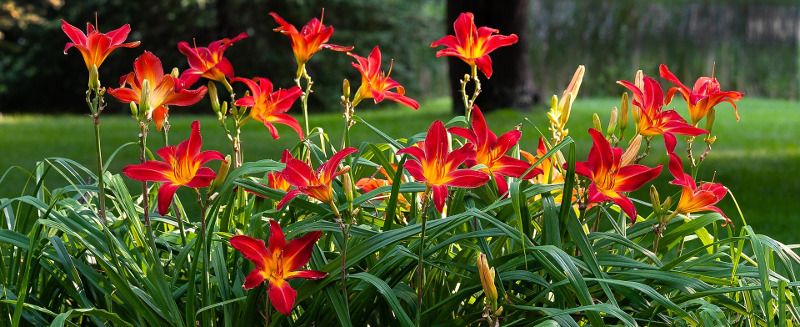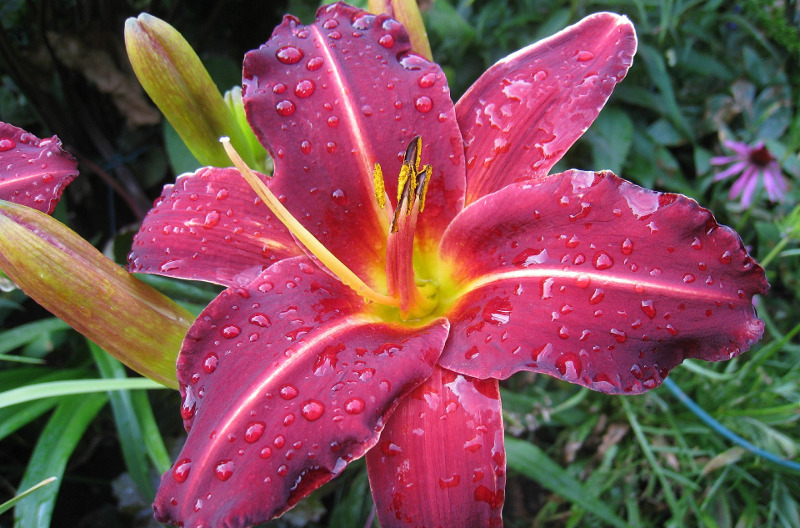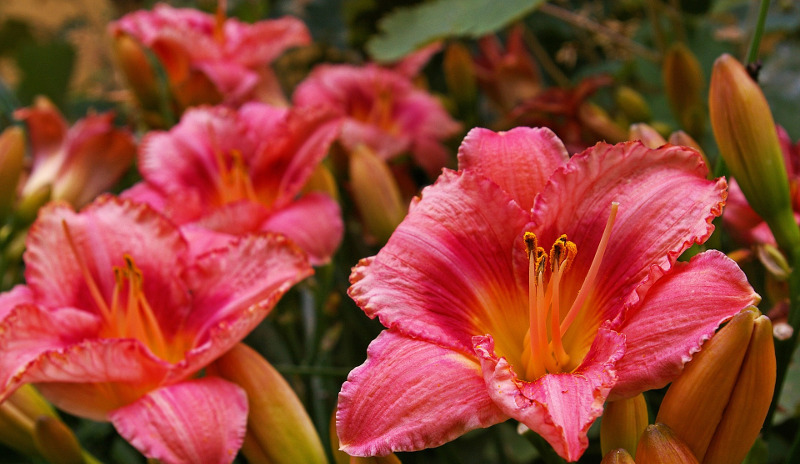Hemerocallis is Greek for “beauty for a day,” since most of the blooms live only a day, but daylily plants are so prolific, you’ll hardly notice. A single plant can produce 200-400 blossoms in a season.
The family of about 15 species hails from Asia and Central Europe. Their ease of propagation has led to hundreds of cultivars, including once- and repeat bloomers, single and double flowers, some even with fragrance. They can range from 12-inch miniatures to close to four feet tall and the foliage can be semi- to fully evergreen. Daylilies sport all the colors except pure white and true blue.

Daylilies thrive in USDA hardiness zones 3-9, are adaptable and easy to grow. They can be mixed in perennial borders or used en masse as a weed-suppressing casual edging. They make a great pairing with spring bulbs like daffodils. They grow happily in sun to partial shade. They feed pollinators including butterflies, bees, and hummingbirds. They even can be planted under black walnuts, because they are immune to the chemical juglone the trees emit.
Planting Daylilies
Choose a site with well-drained, loamy soil with six hours of sun, ideally in the morning to early afternoon. In greater shade, they will bloom less.
Amend with compost if soil is very sandy or clay. Trim any leaves to six inches. Dig the hole twice as wide as the roots and as deep. Place the crown one inch below the soil. Space plants 12 to 18 inches apart and mulch for at least the first year to prevent weed competition. The best timing is in spring or at least six weeks before the last frost in fall.

Watering Daylilies
While drought-tolerant once established, they prefer moist soil. Water especially well the first year. About an inch a day is ideal particularly after bud-set and while blooming.
Fertilizing Daylilies
A balanced fertilizer is best for daylilies, with perhaps some extra nitrogen in spring. Repeat the fertilizer about a month later, and then again in fall. This will encourage lush, larger, bloom, strong growth, and better winter hardiness.
Deadheading Daylilies
Pruning is not necessary, but deadheading seed heads will prolong blooming, especially in reblooming diploid and tetraploid varieties.

Caring For Daylilies in Pots
Use a high-quality potting mix and mulch the plant to preserve moisture. Check for water needs every two- to three days. Consistent watering is key. Repeat slow-release fertilizer monthly in spring; a liquid fertilizer every two weeks up to and through bloom season will encourage the best performance. Keep mulch on in winter.
Winter Care for Daylilies
Mulch the plants well before winter, especially in colder edges of their hardiness range. Early spring or late summer after bloom are perfect times for dividing crowded clumps.
Dividing Daylilies
If your plants are not blooming as much as they used to, it may be time to divide the daylilies. This gives the plants more room to grow and get more nutrients and airflow between the plants. The best time to do this is in the spring or late fall.

Common Daylily Care Questions
Are Daylilies Poisonous?
While not true lilies, which are highly toxic to dogs and cats, daylilies are toxic to cats but not dogs and humans.
Are Daylilies Drought Tolerant?
Daylilies are drought resistant as well as pest and disease resistant and they are very adaptable to many soils and do well in various available sunlight conditions.
Are Daylilies Invasive?
Native to Asia, there are some varieties of daylily that are considered invasive in the United States, none of which we sell. There are many more varieties though, that is non-invasive.
Do Daylilies Spread?
Daylilies will quickly turn into larger clumps of daylilies, which will eventually cause them to bloom less profusely, so they should be divided every few years, taking care to ensure that each division has plenty of roots and several leaf fans.
How To Care For Daylilies In The Summer?
For best quality blooms, water your daylilies at least once a week (depending on rainfall) or more if your soil is sandy or it is a particularly dry year. Watering early in the morning is best, for optimal absorption before evaporation takes place in the heat of the day. Deadheading the spent blooms will send energy to producing more foliage and more blooms rather than seed production,
Why Do Daylilies Leave Turning Yellow And Brown?
Yellowing leaves on daylilies may be caused by under- or over-watering (water when the top inch of soil feels dry,) pests, aphids, or mites (they can be protected by insecticides or insecticidal soaps,) leaf streak, or daylily rust (there are varieties that are resistant.)
Do Daylilies Come Back Every Year?
Daylilies are perennials and come back year after year.
Have a question about Daylilies? Fill out the form below and we will try and get back to your question as soon as possible. We may even feature your question on this article to help other gardeners!
 |
Author Erica Browne Grivas - Published 06-14-2021 |
